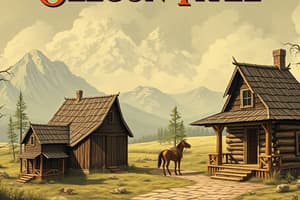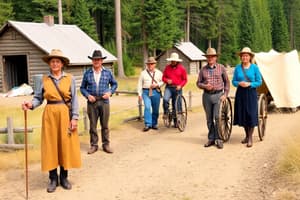Podcast
Questions and Answers
What was the term used to describe the covered wagons used by pioneers on the Oregon Trail?
What was the term used to describe the covered wagons used by pioneers on the Oregon Trail?
- Prairie Ship
- Ship of the Plains (correct)
- Trail Cruiser
- Mountain Wagon
Why was it safer to travel with a wagon train on the Oregon Trail?
Why was it safer to travel with a wagon train on the Oregon Trail?
- To have a larger group of people to protect each other (correct)
- To carry more supplies
- To have more horses to ride
- To have a mountain man as a guide
Who usually rode inside the wagon on the Oregon Trail?
Who usually rode inside the wagon on the Oregon Trail?
- Mountain men and guides
- Only the sick and elderly
- Women and small children (correct)
- Men and women
What was a common danger faced by pioneers on the Oregon Trail?
What was a common danger faced by pioneers on the Oregon Trail?
Why was it an exciting time for those who made the trip on the Oregon Trail?
Why was it an exciting time for those who made the trip on the Oregon Trail?
What was the role of a mountain man on the Oregon Trail?
What was the role of a mountain man on the Oregon Trail?
What was the approximate length of the Oregon Trail?
What was the approximate length of the Oregon Trail?
What was a main advantage of traveling in a wagon train on the Oregon Trail?
What was a main advantage of traveling in a wagon train on the Oregon Trail?
What was the typical daily distance traveled by pioneers on the Oregon Trail?
What was the typical daily distance traveled by pioneers on the Oregon Trail?
What was a common provision carried by pioneers on the Oregon Trail?
What was a common provision carried by pioneers on the Oregon Trail?
Why did many people decide to travel on the Oregon Trail?
Why did many people decide to travel on the Oregon Trail?
When was the Oregon Trail a popular route for pioneers?
When was the Oregon Trail a popular route for pioneers?
What was the primary reason pioneers faced difficulties in crossing rivers?
What was the primary reason pioneers faced difficulties in crossing rivers?
What was the main advantage of using oxen to pull the wagons?
What was the main advantage of using oxen to pull the wagons?
What was a common problem pioneers faced when it came to food?
What was a common problem pioneers faced when it came to food?
Why did pioneers need to be careful not to overload their wagons?
Why did pioneers need to be careful not to overload their wagons?
How long did the pioneers typically prepare for their journey to last?
How long did the pioneers typically prepare for their journey to last?
What motivated the pioneers to continue their journey despite the many challenges?
What motivated the pioneers to continue their journey despite the many challenges?
Flashcards are hidden until you start studying
Study Notes
Traveling the Oregon Trail
- Travelers in the 1840s and 1850s used covered wagons, also known as prairie schooners or ships of the plains, to traverse the Oregon Trail.
- The term "schooner" originated from seagoing ships, and pioneers likened their wagons to ships navigating the plains.
Wagon Trains and Guides
- Traveling in large groups, or wagon trains, was the safest way to make the journey.
- Mountain men often served as guides for these wagon trains, as they possessed extensive knowledge of the plains.
Life on the Trail
- Only women, small children, and sick people rode inside the wagons, while everyone else walked or rode horses alongside.
- Travelers faced numerous challenges, including mud, dust, insects, snakes, rough terrain, treacherous rivers and streams, and the risks of Indian country.
- Many pioneers became sick and died along the trail.
Packing the Prairie Schooner
- A pioneer family would pack essential items, including:
- Multiple bags of rice (at least three)
The Oregon Trail
- The Oregon Trail was a 2,170-mile long journey that took approximately six months to complete.
- The trail stretched from the Missouri River to Oregon Territory.
- Travelers formed large groups called wagon trains for safety and support.
Wagon Trains
- Wagon trains were pulled by oxen and could carry 1,600 to 2,000 pounds of supplies.
- Wagons were called "prairie schooners" due to their canvas cover resembling a ship's sail.
- Pioneers walked alongside their wagons, which were about 10 feet long and 4 feet wide.
Provisions and Meals
- Pioneers had to bring all their provisions, including food and tools, as they couldn't rely on finding what they needed along the way.
- Meals typically consisted of coffee, bacon, beans, and fried cakes made from water and flour fried in bacon fat.
Dangers and Challenges
- Travelers faced many dangers, including illness, exhaustion, bad weather, snake bites, and robbers.
- The journey was long and hard, with pioneers traveling about 10 to 20 miles a day.
- Rough terrain and dangerous river crossings were major challenges.
Motivations and Outcomes
- Many people traveled the Oregon Trail to escape crowded cities and find a better life in the West.
- Some pioneers went to escape from crimes or creditors, while others wanted to farm their own land.
- The Homestead Act made it possible for people to own land and start a new life.
- Despite the challenges, pioneers believed in a better future for themselves and their families.
Studying That Suits You
Use AI to generate personalized quizzes and flashcards to suit your learning preferences.




